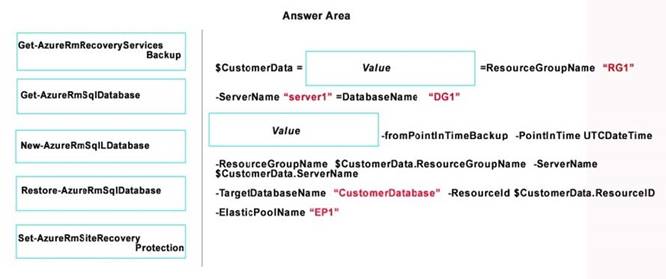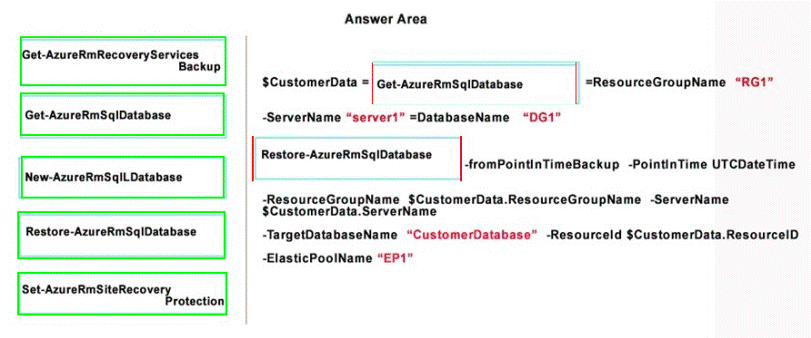- All Exams Instant Download
Which cmdlets should you use in the Azure PowerShell script?
Topic 4, Relecloud
Overview
General overview
Relecloud is an international data services company that has 3,000 users. The company has a sale department a marketing department a research department and a human resources department.
Physical location
Relecloud has one office in Seattle. The company has customers through cut North America and Europe.
Relecloud has most of its computing infrastructure located in a datacenter in Los Angeles. The company also has a few servers that are configured as Microsoft Azure virtual machines.
Existing Environment
Active Directory
The network contains an active Directory forest named relecloud.com. The forest contains two domains named relecloud.com and relecloud local. The functional level of the domain is Window Server 2008 R2.
Each office contains five domain controllers. Each office is configured as an Active Directory site.
Current business model
Relecloud maintains a single Microsoft SQL Server database named Database 1. Database 1 hosts all of the data for the customers of Relecloud. Database 1 has a total of 600 GB of data.
Relecloud provides data for its customers by using several method of delivery. such as comma-separated value (CSV) files and fixed-width text files. All of the files are delivered by using file Transfer protocol (FTP) or Secure FTP (SFTP).
The SQL Server environment contains two on-premises servers and one server in the Azure region of US West. The Azure of US West, The Azure infrastructure contains an ExpressRoute connection.
The network contains the SQL server configured as shown in the following table.

ServerDB1 and Server DB2 are members of an availability group. Problem statements Relecloud identifies several issues with its current data storage model. Multiple customers report
that they have issues loading files into relational databases. Additionally, Relecloud administrators often fail to communicate with the FTP servers of the Relecloud customers. Currently, the memory and the CPU of ServerDB1 and ServerDB2 are nearly fully utilized.
Requirements
Business goals
Relecloud plans to take a leadership role in its industry and modernize its delivery method. The company also plans to offer its customers easier access to its data.
Planned changes
Relecloud plans to move all of its customers to a delivery model that uses Azure SQL Database and plans to maintain a single database for each customer.
Relecloud plans to automate the process of creating the required infrastructure for each new customers is approximately 10 GB and has a static size. The new customers require a rapid response time to database queries and each customer has five to concurrent logins.
Security requirements
Relecloud identifies the following security requirements:
Customers must be able to read data only.
Customers must be able to create custom views.
Customers must be able to use two-factor authentication when accessing Azure SQL databases.
Technical requirements
Relecloud identifies the following technical requirements:
Database administrators must be notified when the CPU pressure of AzD801 must be able to respond to customer requests for data.
Auditing requirements:
All of the requests from the stored procedures that are run against the Azure SQL databases must be logged. All auditing information must be viewable in Microsoft Excel in Real-time.
DRAG DROP
You plan to prepare the environment for the planned new customers. You need to deploy a base copy of DB1 for each customer in Azure.
Which cmdlets should you use in the Azure PowerShell script? To answer, drag the appropriate
values to the correct targets. Each value may be used once, more than once, or not at all. You may need to drag the split bar between panes or scroll to view content. NOTE: Each correct selection is worth one point.

Answer: 
Explanation:
Box 1: Get-AzureRmSqlDatabase The Get-AzureRmSqlDatabase cmdlet gets one or more Azure SQL databases from an Azure SQL Database Server. Partial syntax: Get-AzureRmSqlDatabase [[-DatabaseName] <String>] [-ServerName] <String> [-ResourceGroupName] <String>
Box 2: Restore-AzureRmSqlDatabase The Restore-AzureRmSqlDatabase cmdlet restores a SQL database from a geo-redundant backup, a backup of a deleted database, a long term retention backup, or a point in time in a live database. The restored database is created as a new database.
Partial syntax: Restore-AzureRmSqlDatabase [-FromLongTermRetentionBackup] -ResourceId <String> -ServerName <String> -TargetDatabaseName <String> [-Edition <String>] [-ServiceObjectiveName <String>] [-ElasticPoolName <String>] [-AsJob] [-LicenseType <String>] [-ResourceGroupName] <String> [-DefaultProfile <IAzureContextContainer>] [<CommonParameters>]
e:
https://docs.microsoft.com/en-us/powershell/module/azurerm.sql/getazurermsqldatabase?view=azurermps-6.7.0
https://docs.microsoft.com/en-us/powershell/module/azurerm.sql/restoreazurermsqldatabase?view=azurermps-6.7.0
Latest 70-473 Dumps Valid Version with 162 Q&As
Latest And Valid Q&A | Instant Download | Once Fail, Full Refund
Subscribe
Login
0 Comments
Inline Feedbacks
View all comments

